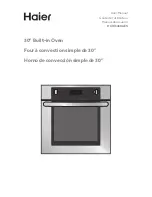
14
5. Waituntilthe HeatOnindicator hascomeonandgoneoutthree times.Atthattimetheovenwillhave reached the set
cooking temperature.
6. Open the oven doors, loadthe product into the oven, and close thedoors.
7. Youcanuse theCookTimerasa reminderofwhentheremovetheloadfromtheoven.Ifsodesired,
turntheCookTimerknob untiltheindicatormarkpointstothedesired cookingtime(upto55 minutes).
Thetimerknobwillrotate counterclockwiseasthetimerrunsdown,indicating howmuchtimeremains. Youcanturn
theknob whilecookingto increase or decreasetheremainingtime.Whenthe timer runs
out,abuzzerwillsoundforashorttime,thenturnitself off.(Toimmediatelysilencethebuzzer,turnthe
CookTimerknobtotheOFFposition.)Thetimerisareminderto you;
thetimerdoesnotcontrolthe oven.
Ifyouopentheovendoors,theburnersandfanwillshutoffuntilthedoorsareclosed.However,the timer will continue
running even if the doors are open.
Toturnontheinterior oven lights,use the switch located at the bottom of the control panel.
8. Whentheloadhasfinishedcooking,youcanrapidlycooltheloadbyopeningtheovendoors(which
willshutofftheburners)andswitching theFanModetoCOOL(whichwill causethefantoruneven though the doors
are open). For the most rapid cooling, also switchthe Fan Speed switch toHI.
9.Whenyou are donecooking,turntheCookTemperaturecontroltothelowest setting(fully counterclockwise) and
switch the PowerSwitch to OFF.
C
OOKING
H
INTS
Ina convectionoven,thefan-blown circulatingairstripsawaythisinsulatinglayer allowingthe
heattopenetratefasterforquickerbakingandroasting.Hence,in aconvection oven cooking procedures
andtechniquesmay requiresomemodificationfor successful results.As ageneral rule,the cooking time will be
shorter and the cooking temperature will be 25°F to 75°F lower than those called for in recipes for
astandard oven.
TIME & TEMPERATURE
Timeandtemperature areimportant.The“GuidetoTimesandTemperatures”laterinthissectionisa
startingpoint.Theactualbestcookingtimeandtemperaturewilldependonsuchfactorsassizeofload andmixture
ofrecipe(particularlymoisture).Onceanappropriatetime andtemperaturehasbeen established for a particular
product and load, you willfind the result of succeeding loads to be similar.
OVERLOADING
Do NOToverloadtheoven.The size oftheloadthatcan be cooked satisfactorilydependslargelyon the
particularproduct.Asa rule,fiveracks can be successfullyusedforshallowcakes,cookies, pies,etc.For deeper
cakes(suchasangelfood),useonlythree racksbecauseofthesize ofthepanandthespace requiredforrising.
Forhamburgerpatties,fish sticks,cheese sandwiches,etc.,afull complementof racks and pans is usually
satisfactory.
HELPFULSUGGESTIONS
Herearesomesuggestionsthatwillassistingettingthebestpossibleperformancefromaconvection oven:
•
Pre-heat the oven thoroughly before use.
•
Whenre-thermalizingfrozenproducts,pre-heattheovento50°Fhigherthantheplannedcooking temperature.After
loading,reduce the temperaturesetting to the appropriatecooking temperature.
•
Space theracks and pans as evenly as possible to allow aircirculation.
•
Centertheloadontherackstoallowforproperaircirculationaroundthesides.Donotcovertheracks completely with
pans.
•
Donotuseadeeppanforshallowcakesorcookies,etc.Aircirculationacrossthesurfaceofthe product is essential.
Summary of Contents for BFCO-1
Page 6: ...6 ...
Page 21: ...21 ...
Page 22: ...22 ...
Page 24: ...24 Electrical Schematic for 120 Volt ...
Page 25: ...25 ...
Page 26: ...26 PARTS ...
Page 27: ...27 ...
Page 28: ...28 ...
Page 29: ...29 ...















































